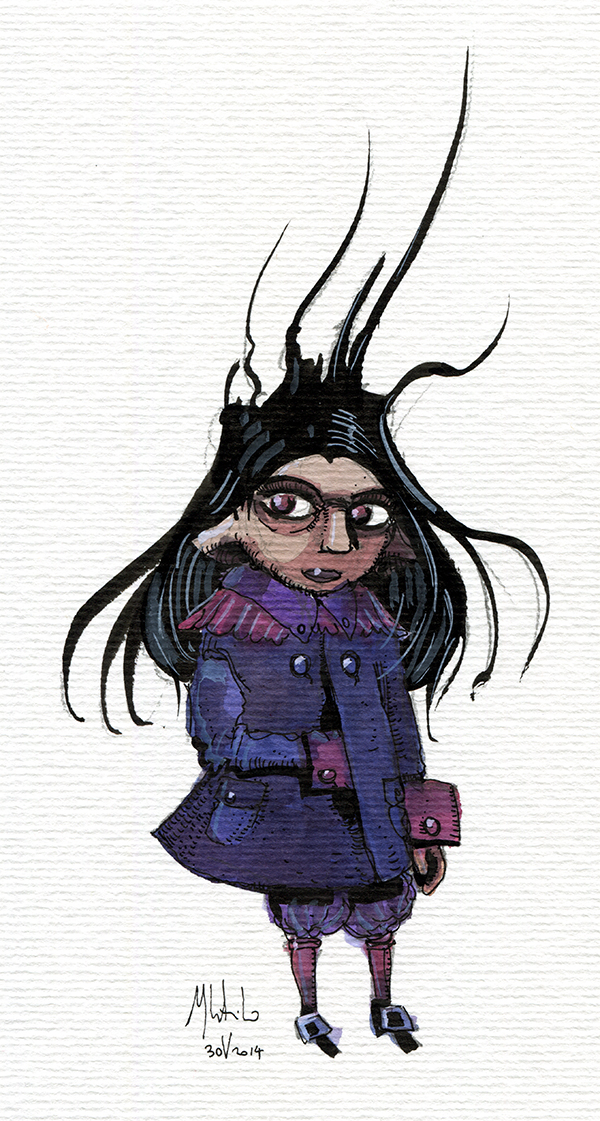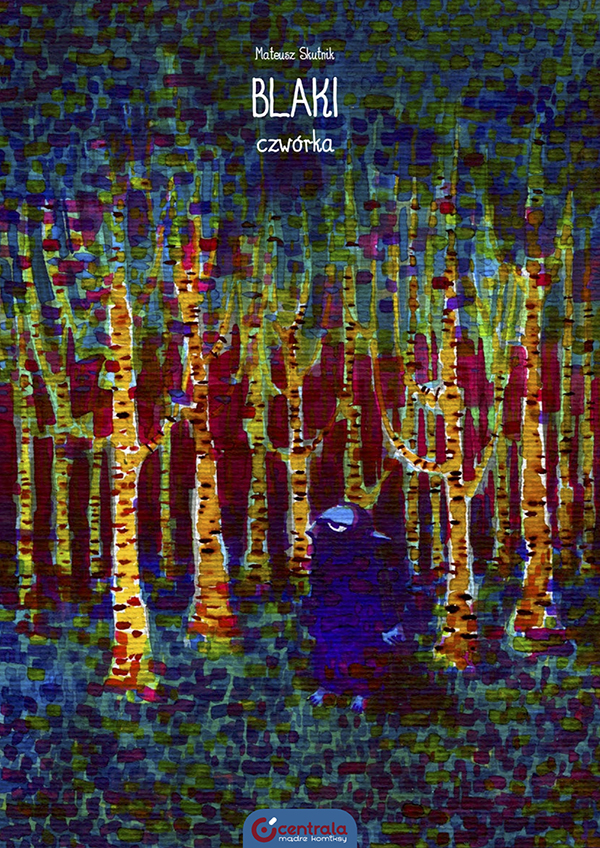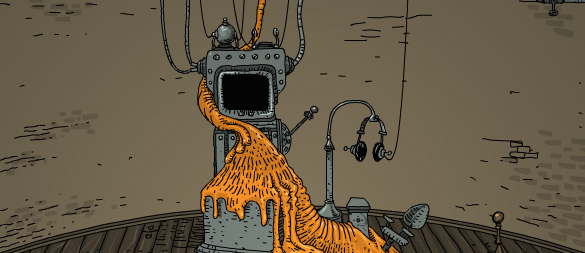Daymare Watercolor
May 30, 2014


przykładowe plansze | sample pages | cover closeup | watch trailer
start | finish | ink closeup | sketches | O | best of 2014 award
exhibitions: Bialystok | Birminham
W 2007 roku powiedziałem, że kontynuacji serii Blaki nie będzie, ponieważ wszystko co było do powiedzenia w tej formule zostało już powiedziane. Pięć lat później okazało się, że to kompletna bzdura, a życie toczy się dalej. W środku tego albumu znajdziecie również odpowiedź na pytanie dlaczego pomiędzy kolejnymi tomami serii musiało upłynąć ponad pół dekady. W dużym skrócie – przedstawiamy drugą fazę życia Blakiego. Lata średnie.
format: A4 | ilość stron: 64 | wnętrze: czarno-białe | okładka: twarda
oprawa: szyta i klejona | ISBN: 978-83-63892-31-9
—-
In 2007 I said that there won’t be continuation of Blaki comic series, because everything there was to say has already been said. Five years later it turns out that it’s utter nonsense and that life just goes on. Inside this album you will also find an answer to the question why it had to pass five years since the previous installment. Long story short – here’s the second phase of life of mr. Blaki. The middle age.
size: A4 (21×29.5 cm / 8.5 x 11.5 inch) | number of pages: 64 | inside: black & white
cover: hard | binding: sewn & glued | ISBN: 978-0-9929082-1-8
—-
Recenzje:
Reviews:
 Końcówka była hardcorowa. Tak zażartej walki o miejsca w finałowej 15-tce nie spodziewał się żaden z jurorów. O wygranej jednych i przegranej drugich zaważyły setne i dziesiętne! Ostatnie godziny głosowania na zgłoszone do konkursu Indie Basement 2.0 gry to walka nerwów w gronie twórców oraz spory stres i rozterki wśród członków międzynarodowego jury. Dominik Głowacki i przewodniczący zespołu sędziowskiego Johannes Wadin nie mieli łatwego zadania, bowiem w wyścigu o dwa miejsca w finale prześcigały się nieustannie cztery idące łeb w łeb produkcje. Po wielu analizach, TOP 15 konkursu Indie Basement 2.0 przybrało ostateczną formę:
Końcówka była hardcorowa. Tak zażartej walki o miejsca w finałowej 15-tce nie spodziewał się żaden z jurorów. O wygranej jednych i przegranej drugich zaważyły setne i dziesiętne! Ostatnie godziny głosowania na zgłoszone do konkursu Indie Basement 2.0 gry to walka nerwów w gronie twórców oraz spory stres i rozterki wśród członków międzynarodowego jury. Dominik Głowacki i przewodniczący zespołu sędziowskiego Johannes Wadin nie mieli łatwego zadania, bowiem w wyścigu o dwa miejsca w finale prześcigały się nieustannie cztery idące łeb w łeb produkcje. Po wielu analizach, TOP 15 konkursu Indie Basement 2.0 przybrało ostateczną formę:
Kolejność najlepszych gier konkursu Indie Basement 2.0 jest alfabetyczna. Już niebawem ujawnimy nominacje w poszczególnych kategoriach. Twórcy finałowych gier zawalczą o następujące nagrody: licencję UNITY PRO, polską i angielską lokalizację gry ufundowaną przez mocap.pl, pakiet wartości 1500zł na udźwiękowienie swojej produkcji od firmy SoundIT, tablety Pentagram Quadra 7 Ultra Slim oraz słuchawki Plantronics. Jeśli chcesz poznać zwycięzców, którym nasza redakcja ufunduje pamiątkową statuetkę i dyplomy, przyjedź na retro imprezę Pixel Heaven 2014 do Warszawy już 31 maja 1 czerwca! To właśnie tam odbędzie się wystawa gier i uroczysta ceremonia wręczenia nagród z udziałem 1ndie World i jurorów!
—- u p d a t e —-
W zeszłym tygodniu po długich naradach wyłoniliśmy wreszcie finałową 15-tkę największego w Polsce konkursu dla twórców niezależnych Indie Basement 2.0. Dziś mamy dla Was kolejną istotną informację – jury wybrało nominacje w kategoriach. Ogłoszoną w materiałach promocyjnych kategorię Fresh Air zastąpiła kategoria Best Art. Już 1 czerwca w Warszawie podczas Pixel Heaven 2014 odbędzie się uroczysta ceremonia wręczenia nagród z udziałem jurorów, redakcji 1ndie World, organizatorów eventu Dominika Głowackiego i Roberta Łapińskiego oraz sponsorów. Wówczas też dowiemy się, która z finałowych gier wygrała nagrodę Grand Prix i miano najlepszej gry konkursu Indie Basement 2.0! Poniżej znajdziecie nominacje: #BEST GAMEPLAY
#BEST ART
#BEST SOUND
#BEST STORY
Wszystkim finalistom redakcja 1ndie World życzy powodzenia!

There are a lot of game developers out there, but few have achieved the cult following and widespread popularity of Mateusz Skutnik. From the post-apocalyptic tale of The Fog Fall to the simple yet oh-so-stylish puzzling of his charming 10 Gnomes games, Mateusz has taken players around the world on memorable point-and-click adventures, to say nothing of his smash-hit ten year series of Submachine games. It’s hard to believe he gets any time off at all… just one month after the first Submachine game, he released Submachine Remix, which dramatically expanded upon the original. Since 2005, he’s made or been involved in the creation of a staggering amount of free online games, to the point where it isn’t officially the New Year until he’s released a new installment of his Where Is… ? series to ring it in. Just lately, he’s agreed to work on a very special project for us, an escape game just for JayisGames, but then, he’s always working on something special, from comics to tutorials, to special HD versions of the games people love. What’s your favourite Mateusz Skutnik game? What was the first one you ever played? Do you like them whimsical… or just a little freaky? What’s your favourite thing about them… what makes, for you, a Mateusz game, a Mateusz game?
A big focus of your games is usually story and setting. Is there any sort of story genre that you haven’t tried yet but have always wanted to?
Not really. I’m not looking at genres while writing a story. Often when I write… I don’t know what will come out of it. The readers and players determine whether that thing that I did is cute or disturbingly fascinating. That concerns mostly graphics, but story as well. Long story short, I don’t know in what genres I operate. I don’t know what genres I’m missing here.
Few people actually think about or understand the time, effort, and talent that goes into creating the games they play online for free. What is the process like in creating the average point-and-click adventure you make?
60% is thinking, imagining, writing, going through the game in my head. Another 30% is drawing everything. 5% is programming and the last 5% is all other stuff, like engine integration, implementing sound effects, music, debugging, beta-testing, releasing…
Submachine recently released its ninth installment… and has been going on for nine years to boot! Has the series changed direction or vision significantly since you first began, or have you always had a specific storyline in mind?
No, of course not. When first one came out I didn’t even have a plan for a sequel. But the overwhelming popularity of this game dictated that it turned into series which is now closing to a ten-year run. I have a not-so-clear vision of the entire plot, but creating each installment is shaping the game to its final state. And with that, the overall story as well. I had a rather clear idea about how the series will end by the time Submachine 5 was released, but how we’d get there… I had no clue. Now, after Submachine 9 we know.
Out of all the different settings and storylines you’ve worked with and created over the years, is there any one in particular that you find the hardest to work with, or the easiest? Something that just “comes to you”, while another you might find yourself really puzzling over how to proceed with it?
For me there’s no such thing as a setting that’s hard to work with. I don’t struggle with my games, I let them flow, my games are like a river, they take the easiest path to the sea. It’s about floating alongside that river. It’s kind of hard to explain, but that work that I do while creating games isn’t really “a work”… it’s more like drawing my comic books. If I don’t feel good while creating… I just don’t do it.
Most of the Submachine games have a very distinctive approach to puzzle solving and exploration. What’s most challenging about coming up with puzzles that fit their environment and are often something the player needs to experiment with to understand, without going overboard to the point where the design gets too obscure?
I always had a fixed answer to that question, which is… I don’t know. But the more I think about it, the more I know there’s more to it. I think that’s because I, myself, am an average gamer. I probably wouldn’t be able to solve a Submachine game if it wasn’t me who made it. So I’m just pushing the puzzle design right out of my reach, and that’s that golden spot, not too hard, not too simple, just average enough.
Have you ever thought about creating a game in something other than flash, such as Unity or HTML5?
I have, and we did. We, as in Pastel Games. But that didn’t go so well for us. However, I’ll probably be moving away from flash-based games starting from 2015, I’m thinking about creating a game that I’d be able to put on Steam. But that’s distant future, right now I have a series to finish. I can’t abandon my players who’ve been waiting almost 10 years for the resolution in Submachine series (What, pressure? No, no pressure at all…).
Finally, you have a lot of different multipart games you’ve been working on over the years. Do you have anything new you’re thinking about starting, or are you planning to focus on the stories and games you’ve already got going?
No, no new series for now. I’m saving that for something completely different, big and bold and sparkling new that I’d be able to put on Steam and earn a pot of gold. Meanwhile wrapping up the flash-based part of my life, I’m creating HD remakes of my best games, which are available in my store.
Why play it?
The Daymare Town series is instantly recognizable due to Mateusz Skutnik’s sketchy artstyle. Skutnik makes particularly good use of heavy lines to add presence to the darker corners of the eponymous town, suggesting a sinister belly lies just underneath the sunny disposition. He’s especially talented in giving tangibility to the hard textures of architecture. It gives the buildings a life and history of their own — a blank wall is never just that — which is very important as you’ll be staring at them a lot.
Throughout each of the games is an unsettingly quietness, as if something is watching you, and doing its best to keep out-of-sight. That said, sometimes you will meet the inhabitants of the town and soon wish you hadn’t. They’re fond of staring, moving around behind your back, and working against your intentions. But who can blame them? It’s you who has walked in on their turf during their personal time.
The Daymare Town series is worth playing for the eerie ambiance and peculiar architecture that you’re left to fumble with; finding hidden passages, mechanisms, notes stuffed in holes. I particularly love learning how the strange, esoteric objects you find connect with the environment, or their significance to their owners.
There are some rough spots where a solution to a puzzle isn’t as obvious as it should be, but that’s easy to glean over due to the coalescence of art, puzzles, and mystery.
Chris Priestman